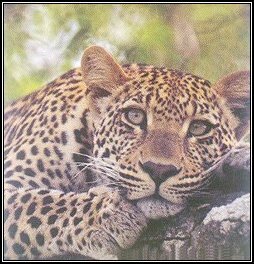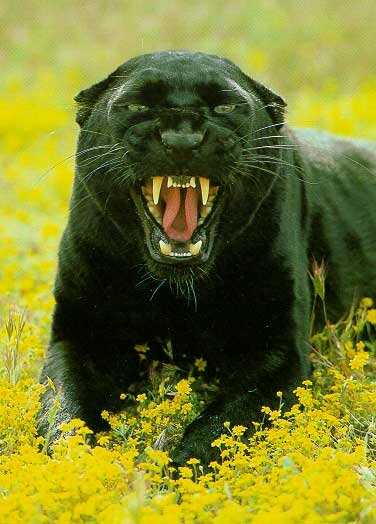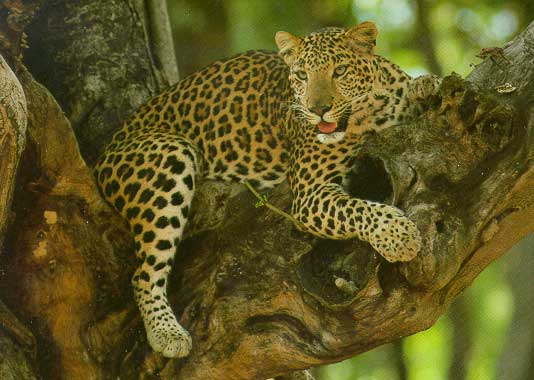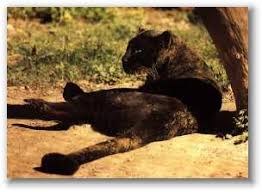Leopard
Scientific Name:
Panthera Pardus
Size
Length: 5 to 8.5 feet
Weight: 55 to 150 lbs.

Animal of the Month:
|
This month Leopard Scientific Name: Size |
 |
Consider the perfect predator, The leopard is the most successful of the Big Cats. (Lion, Tiger, Jaguar, Leopard). It is also the smallest. I know what you're thinking -- why didn't you mention the Cheetah? Simply put, the cheetah, like many other large cats cannot roar. The ability to roar is one of the qualities that separates the leopard and the other big cats from all other members of the cat family.
 There are many spotted cats but only one true leopard. Clouded leopards, and snow leopards while beautiful and astonishing in their own rights are not true leopards. Of special note is the black panther. Once thought to be a species all unto itself, it is in fact a leopard with a black coat. If you look closely at a black panther you can actually see its spots. The black fur is caused by malanism. Black leopards are more common in dense jungle areas and can be born in the same litter with spotted leopards.
There are many spotted cats but only one true leopard. Clouded leopards, and snow leopards while beautiful and astonishing in their own rights are not true leopards. Of special note is the black panther. Once thought to be a species all unto itself, it is in fact a leopard with a black coat. If you look closely at a black panther you can actually see its spots. The black fur is caused by malanism. Black leopards are more common in dense jungle areas and can be born in the same litter with spotted leopards.
One reason why leopards are so successful is because they are the most cat like of all cats. They climb trees with ease, they eat anything they can catch, and they avoid danger if at all possible. A leopard's diet includes Impala, Bushbuck, Warthog, Kudu and Waterbuck. Rodents,ground birds, monkeys, baboons, frogs and fish. They will also prey on the young of larger animals such as zebra and wildebeest.
The warthog and baboon are both worthy advesaries that could easily harm or kill the leopard but it is believed leopards just like the way they taste. While it is uncommon, sick or old leopards have been known to feed on humans. This diverse diet helps the leopard succeed where other animals fail. Lions and tigers rarely prey on small rodents or birds so the leopard doesn't always have to compete with its bigger cousins for a meal.
Leopards are the most successful of the big hunters but they are not the strongest. The chief rivals of the leopard in Africa are the hyenas and the lion. In Asia, the leopard must be on the look out for the tiger. It is often harder for a leopard to protect its prey than it is for it to catch in the first place. Lions and hyenas are quick to locate a dead animal and will steal it from the hapless leopard. Hyenas are pack animals and will use their numbers to take the prey away from the leopard. If the leopard puts up a fight the hyenas will use their superior numbers to kill the leopard. The lion and tiger both out weigh the the leopard by several hundred pounds and will use their awesome power to kill a leopard. However none of these advesaries are willing to attack a leopard just for sport and leopards are experts at avoiding a fight at all cost.
Unlike the tiger, lion, and hyena, a leopard can climb trees, and they can climb them with grace and skill. A leopard has no problem carrying a carcass that weigh more than its own body weight up a tree. Once the leopard hauls the carcass up the tree it can usually eat in peace. Unlike the cheetah and many other animals, a leopard also has no problem with rancid (rotting) meat. It can and does eat spoiled meat with no problem.
 Leopards normally hunt at night and dusk, staying in secluded spots during the day or lying in high branches of trees. They are solitary animals by nature, only associating with a female for mating and staying with her only for a couple of days. Unlike cheetahs and lions, the leopard is a master of camouflage and prefers to ambush its prey at close range. While it is remarkably fast, it will not chase any prey for any length of time. It rarely has to. The prey is normally killed with a bite on the back of the neck. The leopards canines are designed to cut through the neck bones and severe the spinal chord. Its jaws are powerful enough to crush an animals windpipe and cause suffocation. Leopards are extremely territorial animals when it comes to other leopards but they have no problem sharing their area with other predatory cats because they tend to feed on whatever the other animal isn't eating. Their life span is about 15 years in the wild and around 30 in zoos.
Leopards normally hunt at night and dusk, staying in secluded spots during the day or lying in high branches of trees. They are solitary animals by nature, only associating with a female for mating and staying with her only for a couple of days. Unlike cheetahs and lions, the leopard is a master of camouflage and prefers to ambush its prey at close range. While it is remarkably fast, it will not chase any prey for any length of time. It rarely has to. The prey is normally killed with a bite on the back of the neck. The leopards canines are designed to cut through the neck bones and severe the spinal chord. Its jaws are powerful enough to crush an animals windpipe and cause suffocation. Leopards are extremely territorial animals when it comes to other leopards but they have no problem sharing their area with other predatory cats because they tend to feed on whatever the other animal isn't eating. Their life span is about 15 years in the wild and around 30 in zoos.
No other wild or big cat has such a wide range than the leopard. From most of Africa throughout parts of Asia and the Middle East into India, Pakistan, China, Siberia, and South East Asia and the islands of Java and even Sri Lanka. It is home in the forested areas in the savannah in central and southern Africa, the tropical forests of Asia and the snow-covered mountains of Siberia. It's spotted coat creates a perfect camouflage in the trees, when stalking at night or laying quietly in the sun-dappled shade.
|
Leopard ANON (from the Yoruba [trans. Ulli Beier]) Gentle hunter his tail plays on the ground while he crushes the skull. Beautiful death who pouts on a spotted robe when he goes to his victim. Playful killer whose loving embrace splits the antelope's heart. |
 |
|
|
|
|
With thee, in the Desert Emily Dickinson With thee, in the Desert -- |
|
|
|
|
| Check these other great sites: | |